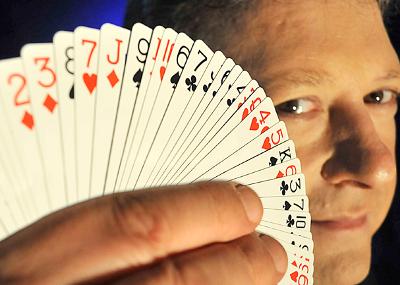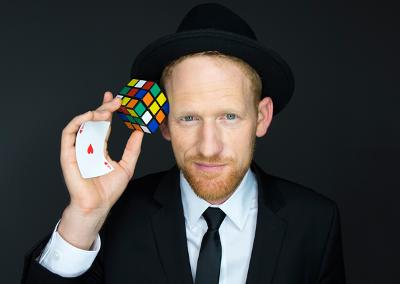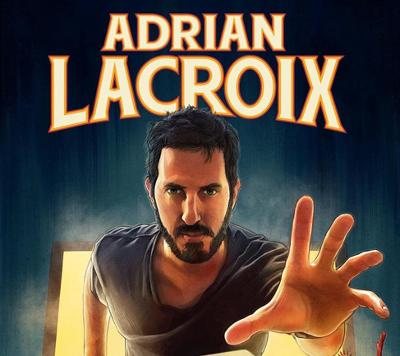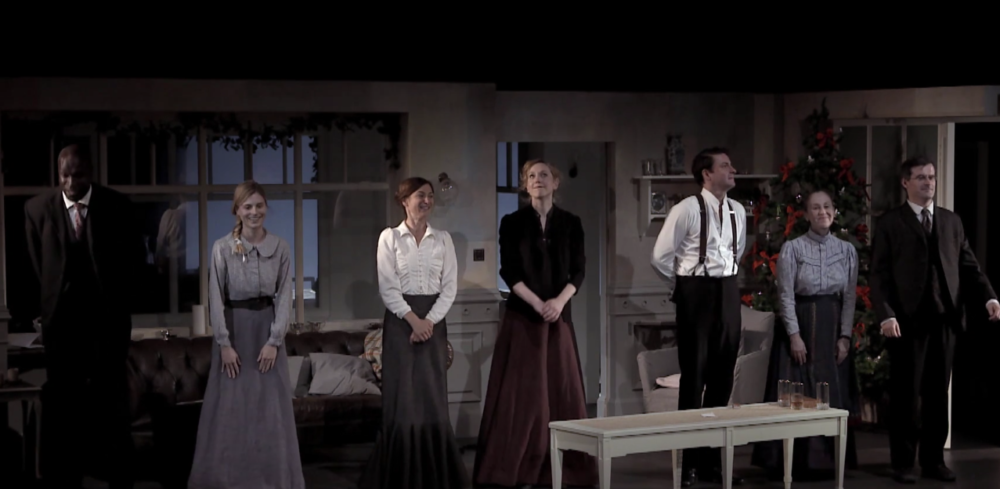by Alix Cohen . . .

At 24, Monday Night Magic is the city’s longest running Off-Broadway magic show. Except in Nevada and at private events, the art seemed to otherwise fade (though never disappear) from popular culture. Michael Chaut, Pete Samelson, Todd Robbins, and Jamy Ian Swiss, all veteran performers, have kept MNM’s flame burning at various Manhattan locations. (Only close-up conjuror Steve Cohen worked here consistently through that time.) Chaut tells me the venerable show shut down in March due to the pandemic and opened as a regularly streamed event in October.
People are curious creatures. If we know an experience includes trickery going in the door, we LIKE to be fooled. Show me something that creates wonder, that raises the question “how?” audiences challenge. Give me a taste of the inexplicable on which most of us were weaned (fairy tales.) In a recent New York Times interview, master illusionist Derek DelGaudio said “You think that I’m going to fool you. So I use that to reveal something true that you can’t believe is true because you think I’m here to deceive you.” Unsettling an audience’s belief paradigm is a magician’s aspiration.

Each Monday, Host David Corsaro, in the field for 27 years, opens with a brief routine. A timely one involves drawing a picture of a “front row” mom. (A special “front row” ticket price offers opportunity to interact- from your home, on camera.) The image is a curly-haired stick figure with an empty cartoon voice bubble. He then folds the paper in half. Suggesting that mom probably curbs her language while her daughters are around, he asks the woman’s substitute exclamation. It’s “shucks.” The folded drawing is opened to reveal “shucks” inside the bubble. http://www.davidcorsaro.com/
Corsaro then introduces the first performer. Each episode features two. After a few tricks, MNM shows a past video of the magician on stage with a volunteer. The infectiously enthusiastic host asks a few questions and the guest does several more routines. At the end of each show, audiences are shown a preview of the next one. This could become addictive.
Some of the fine practitioners I watched:

Henry Evans is the kind of fast-talking showmen who would’ve made a great snake oil salesman. “How can we know what’s going to happen before it does?” he challenges. There are cards with red backs in a wine glass to the right. Evans uses a blue-backed deck. He shuffles and cuts, shuffles and cuts as do a pair of hands from an unseen assistant. The cards are placed in piles, each containing a different number. A volunteer eliminates one pile after another. “Are you sure? Do you want to change your mind?” Evans asks. Reflect for a moment on the power of suggestion.
The magician is left with one pile. He removes those in the glass. There are five cards in the pile, five out of the glass. The same cards in the same order. “Yes!” Evans exclaims. He’s as pleased as the front row. http://www.henryevansmagic.com/en/12.php
Shawn Farquhar seems like the over-excited school principal from an old Matthew Broderick film or perhaps a leprechaun. Farquhar won the Grand Prix at FISM (considered the magic Olympics) and has twice baffled Penn and Teller on their “Fool Us” television show. Asked how that level of preparation differs from the norm, the magician replies that he wasn’t out to trick, but rather to entertain. He drops a padlock into an empty Sprite bottle so casually, it momentarily appears commonplace. In another episode, after a trick, close-up coin expert Eric Jones notes that “these three seconds took ten years of my life.” Moves are rigorously practiced.

An audience member is chosen by dint of coin tosses. Farquhar then displays cards on which he’s already written the stranger’s sex, where he lives, that he loves football “Ok, this is getting freaky,” the man says, and even that he’s wearing sandals- which we can’t see on camera. “Shit!” the participant blurts out. Farquhar also has all of us (me too) turning a small group of coins (any coins) heads to tails and back multiple times at his command. We ALL end on heads. https://www.magichampion.com/
Some in the front row unconsciously lean forward as if to get a better view. (Camera work is clear and close.) Laughter is as common as applause. Almost everyone asked to have a prop ready does so.
Karl Koppertop, a Ron Howard lookalike, has a light, extremely personable performance style. He opens by proving people are more influenced by what they see than what they hear- asking attendees to do one thing while demonstrating another. This recalled the start of mentalist Derren Brown’s live show when he told the audience a gorilla would at some point come onstage and steal a banana from a plinth, but most of us wouldn’t see him. Most didn’t. Forms of misdirection occur every day, particularly political and pharmaceutical ads. An entertaining routine in Farquhar’s stage video finds him literally showing the volunteer how he did a trick. She persists in not seeing it.

The red headed magician asks his audience to dictate how to turn rows on several Rubik’s Cubes. “It’ll solve itself,” he says amiably. And it does. No, I’m not telling you more. Use of the prop is clever. Another appealing approach is a pad on which he’s written 24 items that might be hidden in a table top cylinder, some quite amusing, each on a page. A volunteer picks the page number and the item is withdrawn, as is an item named in passing, as is another Rubik’s Cube. https://www.karlkoppertop.com/
Argentinian Adrian Lacroix is the highlight of my viewing experience. I’m told the artist was/is a mentalist, that these tricks were developed specifically for streaming. His patter is provocative, his skill expert. “Many believe that everything in life is ruled by luck. If I count out 17 cards and the 17th is the card you called out, we’ll be lucky, right?” Lacroix rhetorically asks. Not only is it the chosen king, but the back of the card is red, not blue like the rest of the deck. “The only card that doesn’t match and that’s a lucky coincidence, right?”
“Do I LOOK like the kind of person that would’ve named the king of hearts?!” a volunteer exclaims when her choice shows up somewhere unexpected. “Let’s try this,” Lacroix continues, “Imagine you have a different card in your hand, then throw it towards this wine glass.” (He holds the stem) She does. Her card suddenly appears in the otherwise empty bowl. No camera tricks.

We’re told about legendary South American magician René Lavand who, having lost his hand at the age of nine, taught himself the art of conjuring with only one. Lacroix puts one of his below the table and shuffles with the other. He then recreates a Lavand signature routine, manipulating 6 cards, breaking up black and red suits which miraculously realign themselves according to color again and again no matter how he carefully separates them. Lavand’s catchphrase is repeated: “No se puede hacer más lento” (Spanish for “it cannot be done any slower.”) ‘An accurate description of the measured pace employed to move cards.
The performer quotes a broadcast interview with Lavand in which the latter was asked whether he set out to entertain people. “There are plenty who can do that well, I want to go deeper,” came the response. Do you want to astonish? “Of course…but I want to go deeper,” he replied. We’re told the conjuror set out to evoke what Sigmund Freud considered the deepest feeling a human can have, the anguish felt in the face of deep mystery.
Those at home are then led through a number of machinations that completely mix up their respective decks of cards. Lacroix does the same. The audience is even given choices as to whether it moves cards right to left or left to right between shuffling. “Fine,” he says, “Put yours back in the boxes.” This is, as you might assume, meets with querulous looks. The magician’s deck is fanned out. Four aces are face up, the rest down. Then Lacroix suggests everyone take their decks out of boxes and do the same. The result is duplicated in all decks. Aces up! Magic! https://adrianlacroix.com/
Every Monday at 8pm EST, a different episode of Monday Night Magic is live. Even youngsters are intrigued. There are usually some with their families in the “front row.” February’s Black History Month cornered the market on Black magicians. March belongs to women. Yes there are, and always have been female magicians. Chaut tells me Magician Lisa Menna theorizes that little boys are more attracted to puzzles, so fewer girls get involved when the males do. Most of these practitioners have been at this since their early teens.

Eschewing the use of giant props, scantily clad assistants, wild animals, and Las Vegas frills, episodes feature the magic of Corsaro and two successive professionals at tables. Close-up magic has never been so close. Cards and coins are staple props, but not the only ones employed. If a practitioner wants the audience to have something handy in order to engage at home, ticket buyers are told in advance.
As always, personality and framing are paramount. Some of the routines have been around since time immemorial. The roster of magicians features both weathered practitioners and newcomers. A random sampling included winners of prestigious competitions held by the Olympics of magic at the International Federation of Magic Societies (FISM) (Fédération Internationale des Sociétés Magiques) and awards from Obie’s 4F™ Close-Up Magic Convention (Fetcher’s Finger Flicking Frolic) out of Buffalo, New York.
TICKETS: https://www.stellartickets.com/o/magical-nights-inc/events/monday-night-magic-live-online
With the Stellar Tickets platform, viewers can watch Monday Night Magic: Live Online on any streaming device in your home (PC, laptop, iPad, Fire Stick, Apple TV, Roku, or Smart TV).
VIDEO TRAILER: https://youtu.be/DJd7PdafMPQ


















